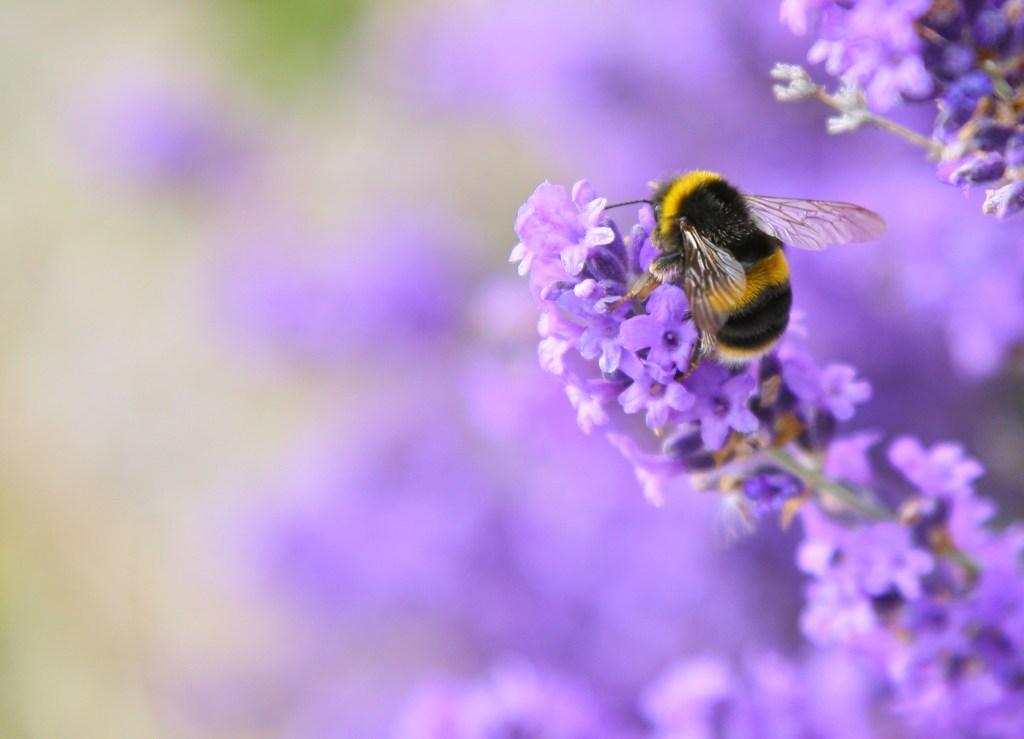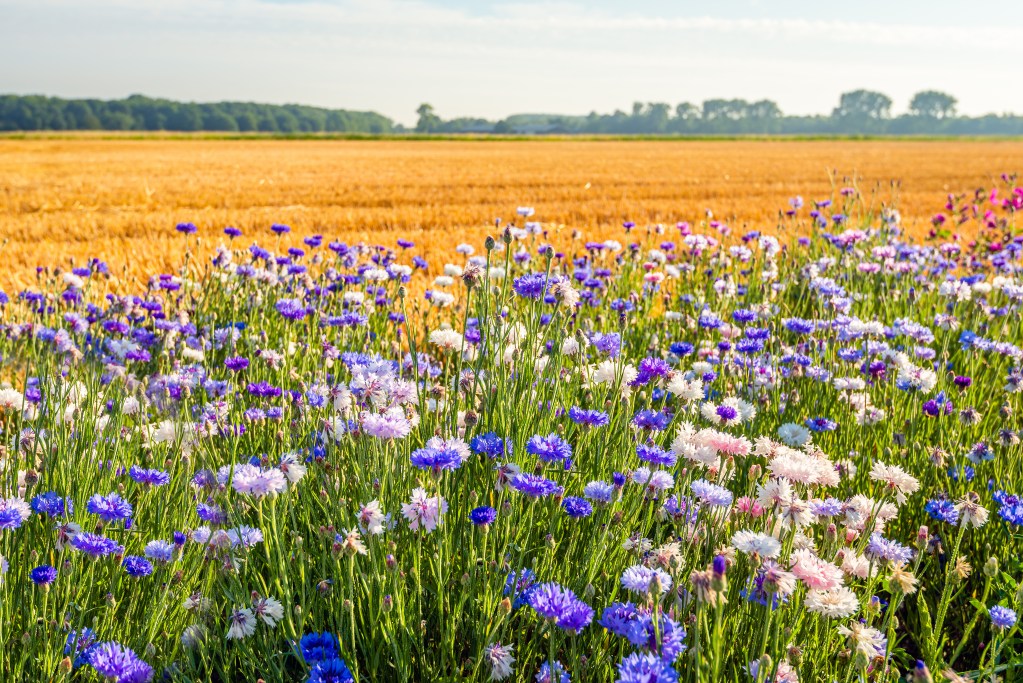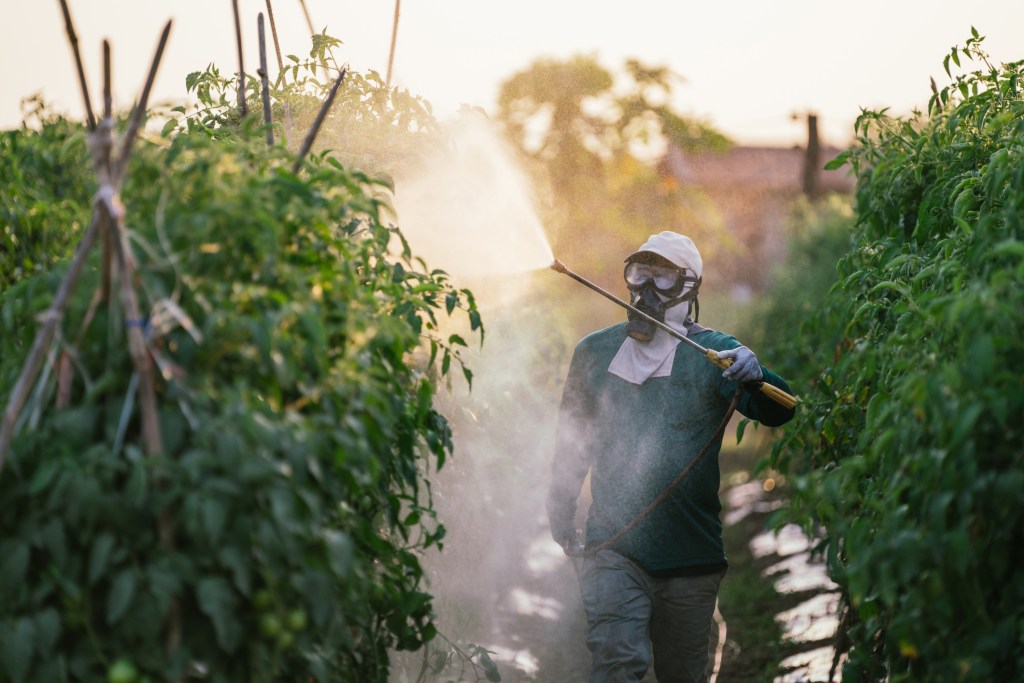A recent study estimates that the pesticide market is now worth nearly $11 billion, and is only expected to grow over the coming decade. This isn’t great news for the environment. We talked to the nonprofit organization, Beyond Pesticides, to learn more.
Beyond Pesticides seeks to protect public health and the environment by working with allies to lead the transition to a world free from toxic pesticides. The term pesticide can be used as an umbrella term to describe a range of products, including insecticides, fungicides, rodenticides, and herbicides; in other words, any biocide registered by the Environmental Protection Agency (EPA).
“The organization’s ultimate goal is to affect change through local action, assisting individuals in community-based organizations to stimulate discussions around the hazards of pesticides while at the same time providing information on safer alternatives,” said Drew Toher, Community Resource and Policy Director at Beyond Pesticides.

Pollinators
Pollinators face dangerous health and population declines due to toxic pesticide use. Even in quantities the EPA deems safe, pesticides have unintended consequences for the pollinators we rely on for our survival. Monarch butterflies reveal a drastic example of pollinator population decline. In the 1980s, 10 million monarch butterflies overwintered along the California west coast, Toher said. By the 1990s, the number fell to about 1.2 million.
“By five years ago, they were counting roughly 300,000. In 2019, numbers have crashed below 30,000,” Toher said. “And now this last year, the count for the western monarch was a mere 2000 butterflies.”
Eastern monarchs have also faced staggering population declines, registering 80% since the 1990s. Bee populations, both managed and wild, experienced similar rapid declines; since 2006, beekeepers reported losing 30% of their hives each year, Toher said. For both American and Rusty Patched bumblebees, populations have declined over 90% across most of their native range.
Pesticides harm pollinators and other wildlife through their acute toxicity, or rather their ability to kill or disable species on-contact, and their chronic toxicity, or their ability to harm species over a period of time.
One class of insecticides known as neonicotinoids, or “neonics,” endanger pollinators through both their high acute toxicity and chronic toxicity. Neonics are whole plant poisons when applied, meaning that they enter the pollen, nectar and dew droplets that plants produce and pollinators feed upon. Once exposed to neonics, Toher said, pollinators face impaired navigation, foraging, and learning behaviors, as well as suppressed immune systems—leaving them vulnerable to disease and pathogens that further degrade population numbers.
Other pollinators—including insect pollinators, hummingbirds, and nectar-loving bats—also experience negative, or even lethal, health consequences when exposed to toxic pesticides. Without them, our food system cannot continue producing crops we rely on.
“1 in 3 bites of food rely on pollinators. Tens of billions of dollars in contributions to the agricultural economy are from pollinators,” Toher said. “And it’s both wild and managed pollinators, we need them both.”

Biodiversity and food security
Biodiversity describes the variety of life on earth, which remains necessary for the stability and richness of our ecosystem. Rich biodiversity increases crops’ resistance to harmful pests, helps stabilize the climate, and leads to greater productivity of each species in the ecosystem.
Pesticide use threatens biodiversity by harming pollinators that support crops, degrading soil, and harming the resiliency of plants to bounce back from pest pressure or detrimental environmental outcomes.
“We have to remember that these chemicals, by their very nature, are designed to kill,” Toher said. “They are generally indiscriminate. So once applied, a pesticide doesn’t stay at the same place.”
As they drift into other areas or run-off into waterways, toxic pesticides result in non-targeted acts, or when a pesticide harms an unintended plant or animal that is not the target pest. Once in the environment, pesticides can be found in dangerous levels in rivers, lakes, and streams—often at levels that far exceed EPA safety limits for aquatic life, Toher said.
“It’s never a single chemical that’s found in waterways, but a broad mixture that includes not only multiple different pesticides, but pharmaceuticals, detergents, fertilizers—a whole range of other industrial compounds,” Toher said. “And these chemicals, they break down into component parts and then they mix back up, and can result in synergistic effects that are greater harm together than any one individual could cause.”
Farmers spray genetically engineered crops, designed to resist pesticide exposure, with herbicides to kill weeds; however, over time, weeds gain natural resistance as well. Subsequently, our current agriculture industry started an epidemic of pesticide-resistant weeds—which then require even more toxic chemicals to control.
Agriculture relies on biodiversity through a negative correlation; as crop diversity increases, pests and pesticide use decreases. In contrast, as biodiversity decreases, pests—and, in turn, pesticide use—increases.
“So as a result, what you see is that farmers have more pests, which requires more pesticide use to control,” Toher said. “You see, this is how conventional chemical intensive agriculture works… We’re spraying pesticides, which is harming the environment, reducing diversity, and reducing that natural resilience—in order to make up for that, you need to spray more pesticides in order to manage the pests that result.”
Climate change
Much like other industries, the pesticide industry requires Petra chemicals and large quantities of “dirty energy,” or energy production that accelerates the climate crisis, to produce the pesticides used by homeowners and the agricultural industry alike.
Pesticide use is often paired with synthetic fertilizer use, which also requires fossil fuels and emits harmful nitrous oxide. Nitrous oxide, a greenhouse gas that contributes to climate change, remains in the atmosphere for nearly 114 years—meaning the impact of 1 pound of nitrous oxide is 300 times more than 1 pound of carbon dioxide.
Carbon dioxide, tied to the burning of fossil fuels for energy production, is often deemed the most important greenhouse gas. While methane and nitrous oxide have a greater impact by scale, carbon dioxide’s abundance in our atmosphere means that it accounts for 2/3 of the energy imbalance driving the climate crisis. Plants help store carbon naturally, but the current agriculture, pesticide, and synthetic fertilizer industries offset any positive contribution crops could theoretically make in the fight against climate change.
“Really, what we need to see is agriculture become a carbon sink, and not a carbon source,” Toher said.
Organic and regenerative practices can help make this a reality. The Rodale Institute, based in Pennsylvania, spent nearly 40 years conducting a farming systems trial that revealed that switching to organic management practices can actually sequester carbon—as opposed to generating greenhouse gases and degrading soil health like current industrial agriculture practices.
For agriculture to be an asset to climate reform, instead of a contributor to climate change, agriculture must be reimagined to eliminate pesticide use. Pesticide use keeps agriculture reliant on other fossil fuel dependent practices through a positive feedback loop.
“[Pesticide use] incentivizes a monoculture, chemically intensive reliant systems that’s reliant on shipping in outside resources, gas guzzling heavy machinery, and industrial fertilizer production,” Toher said. “And we need to move away from that and move rapidly towards organic systems.”
Public health
“Pesticides disproportionately harm the most vulnerable among us,” Toher said. “And children, pregnant mothers, those who are low income, the elderly, those who are immunocompromised, and BIPOC communities… are often the brunt of the government’s failure to create strong measures that protect public health.”
Pesticides don’t only kill plants or pests: Pesticides impact human health, too. Toxic pesticides poison the air, water, and land when applied, resulting in higher risks for cancer for those closest to the source. For children and pregnant people, pesticides pose elevated risks for cancer, birth defects, asthma, and other negative health outcomes.

For those living and working near sources of pesticides, the need to reduce pesticide use cannot wait any longer.
Environmental justice describes how low income communities and communities of color often experience greater and more immediate consequences of pollution, climate change, and other environmental hazards, and addressing this is vital to the pesticide reform movement.
“In addition, the pesticide production facilities—of course, to manufacture these chemicals—they’re often sited in BIPOC communities,” Toher said. “Even pesticide use in parks and playgrounds is higher in black and brown communities.”
Environmental racism describes how this phenomenon impacts individuals and communities based on race specifically. From farms to production facilities to schools and playgrounds, toxic pesticides harm people of color at higher rates than white communities.
These two concepts tie into agricultural justice, a term used to refer to the importance of providing fair wages, protection from hazards, and protection from discrimination or coercion for farmworkers, many of whom are people of color.
In particular, farmworkers are subjected to harsh and dangerous conditions that take a detrimental toll on their health and longevity.
“The average life expectancy for a farm worker is 49 years—compared to 78 for the general population. So farmworkers have roughly the same life expectancy as individuals living in the 1850s,” Toher said. “It’s incredibly disturbing, and this figure alone should be enough to force action to protect the health of farmworkers, right? But time and time again, EPA and other federal agencies have failed to provide simple, common sense protections from toxic pesticide exposure for farmworkers and their families.”
What you can do
While pesticides produce adverse effects on the health of humans, animals, and the environment, gardeners can take active roles in supporting solutions.
“I would say if you want to support our mission, I think the best way is to get engaged in the pesticide reform movement, and that means different things for different people,” Toher said. “I would encourage folks to follow their passions and what concerns them.”
Beyond Pesticides’ website contains a range of program areas: pollinators, biodiversity, threatened waterways, invasive species, mosquito management, and the threat pesticides pose to pets, to name just a few. For each program, Beyond Pesticides poses solutions that individuals can use to influence pesticide use in their backyard, community, state, region, and country.
Safer alternatives to pesticides
Beyond Pesticides has found that much of pesticide use occurs locally, so Toher strongly encourages starting with individual or community intervention to jumpstart a significant impact.
“We encourage individuals to practice ecological pest management and organic landcare,” Toher said. “This approach focuses on pest inspections, monitoring pests, evaluating the need for pest control, and then considering non-toxic control methods first.”
Non-toxic control methods include sanitation, structure repairs, habitat manipulation, mechanical controls, and creating more diversity in the landscape.
For outdoor gardeners, the focus should be working with natural systems. Pesticides essentially help manage an area of land by replacing or mimicking a predator in the environment to eradicate specific pests or weeds to manage an area of land; there are other non-toxic methods to simulate similar results.
For example, weed killer can be replaced with grass seed, Toher said; in the fall, aerate the soil, add a thin layer of compost, and over-seed with the appropriate grass seed. Paired with mowing the grass high and proper watering, this results in thick, green turf that will crowd out any weed seeds and prevent them from germinating.
For indoor gardeners, Toher recommends focusing on pest exclusion: remove any sources of food or water from your home and seal up all pest hiding spots or entryways into your home by caulking all windows and adding door sweeps to all entrances. Better sanitation techniques, like regular disinfecting, sweeping, and vacuuming, can also help keep pests out.
As a very last resort, Toher recommends referring to the list of least toxic pesticides that are compatible with organic landscape management on Beyond Pesticides websites.
Money talks
As consumers, gardeners and those concerned about toxic pesticide use can vote with their dollar.
To stop supporting the pesticide industry, consumers should avoid purchasing toxic pesticides and avoid hiring chemical landscapers. At the grocery store or farmers market, consumers should purchase organic produce if possible and also encourage local grocery stores, garden centers, and hardware stores to stock more organic alternatives.
“You should urge your friends and family to follow your lead in expanding the market for safer products,” Toher said.
Consumers should view gardening, farming, and pest management through an ecological lens, and make purchases accordingly. Boycotting products holds the power to influence the industry.
Policy action
While individuals’ actions add up, collective action can change the industry as a whole, one community at a time. Beyond Pesticides offers direct calls and one-on-one strategic support to work with advocates through their community’s policy making process.
“At Beyond Pesticides, we work directly with concerned individuals to help their community transition from pesticide intensive management to safer, non-toxic measures,” Toher said. “We encourage supporters to find out more about pesticide use in their communities and engage the local officials in your city, county, or town council or board and ask those boards to support local legislation to restrict the use of toxic pesticides.”
Organic landcare and smart purchases can help change the health of your own yard, but demanding policy changes from your representatives tackles the largest producers, distributors, and users of toxic pesticides.
“I think another part is that the environmental protection agency isn’t providing the sort of environmental protection [and] public health protection that communities want and expect,” Toher said. “They understand that there are major deficiencies in the way the EPA reviews and registers these chemicals, and as a result, they take action to eliminate them and move towards these safer practices.”
Many communities, even major metropolitan areas, have pushed government officials to curb the use of toxic pesticides. Earlier this year, New York City passed landmark legislation to end the use of pesticides in public parks and playgrounds, and other cities—like Baltimore and Philadelphia—have also followed suit.
Speak to local officials to support legislation that ensures your community is next.



